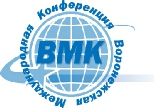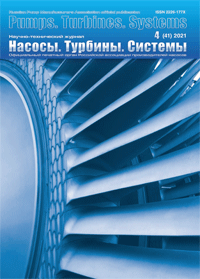Журнал “Насосы.Турбины.Системы”
Адрес:
394026, Россия, г. Воронеж, ул. Газовая, д. 2а, офис 20
Телефон / whats app:
+7 (909) 59-
E-
2001 -
Журнал “НТС”.
Конференция “СИНТ”.

СИНТ

Журнал “НТС” №4 2022 (45)

Архив ”Насосы. Турбины. Системы”
REVIEW OF PROJECTS AND WORKS IN THE FIELD OF DETONATION ENGINES (ENGINES WITH CONTINUOUS SPIN DETONATION)
Aleksandr Aleksandrovich Voronin
Abstract. The paper considers the developments, to which studies of the rotational propagation of detonation in engines with different types of nozzles, namely, a constant area nozzle, a Laval nozzle, a nozzle that diverges, and a nozzle that converges, were conducted. Based on the results of the analysis, it is found that, after the initial transient effects have subsided, the detonation wave maintains continuous oscillatory propagation in the annular chamber as long as the fuel is continuously injected. Among the four nozzle types considered, the Laval nozzle showed the best robot performance. Also, special emphasis is placed on the results of theoretical and experimental studies of internal processes, which were conducted on a special test rig of a rocket engine with a continuous detonation wave.
Keywords: detonation engine, nozzle, wave, oscillation, chamber, field, combustion, temperature.
STATUS, OPPORTUNITIES AND PROSPECTS FOR THE DEVELOPMENT OF THE GRAD SOFTWARE PACKAGE
Boris Mikhaylovich Osipov, Aleksandr Vyacheslavovich Titov, Askar Raufovich Khamatov
Abstract. The possibilities of using and applying the GDCAE (Gas Dynamic Calculations of Aircraft Engines) and the Automated System for Gas Dynamic Calculation of Power Turbomachines (AS GDCPT) in the design and development of gas turbine engines are shown. Ways of development and improvement of these systems are given.
Keywords: GDCAE software package, GDCPT automated system, gas turbine engines, mathematical model.
HYDRODYNAMIC AND GEOMETRIC FACTORS OF SURFACE QUALITY CONTROL AFTER ELECTRIC ARC TREATMENTS
Margarita Ivanovna Popova, Olga Ivanovna Popova, Sergey Vladimirovich Safonov
Abstract. The article considers the hydrodynamic and geometric factors that can be used to effectively control the quality of the surface after processing with an electric arc. As a result of metallographic studies, it was found that under the conditions of the experiment, the depth of the heat-
Keywords: dimensional processing by an electric arc, tool electrode, interelectrode gap, roughness, depth of the heat-
LEAN DESIGN IN THE PROCESS OF IMPORT SUBSTITUTION IN JSC METALIST-
Maksim Konstantinovich Glebovitskiy, Yaroslavna Vladimirovna Kuznetsova, Dmitriy Gennadevich Fedorchenko
Abstract. Issues of lean production are currently given great importance. However, lean production is provided by lean design, which is not sufficiently covered in the literature. The examples of repairs and manufacture of components of foreign gas turbine engines show the need to introduce lean design to ensure repairs and production of their analogues in order to ensure import dependence of Russia in the field of gas turbine building.
Keywords: import substitution, gas turbine engines, repair, manufacturing, the combustion chamber.
INCREASING THE RELIABILITY OF THE RHA SYSTEM OF THE AIRCRAFT GTE COMPRESSOR THROUGH THE USE OF BUSHINGS WITH MOLYBDENUM COATING
Sergey Viktorinovich Falaleev, Valeriy Borisovich Balyakin, Artem Alekseevich Yurtaev, Dmitriy Evgenevich Dolgikh
Abstract. When creating modern aircraft gas turbine engines, a special role is given to the design of systems that ensure reliability and optimal operating parameters during engine operation. One such system is the compressor guide vane control system. The article analyzes the operating conditions of the guide vanes control system and the loads that occur in the system during operation. As a result, the number of possible operation of the system was determined, which depends on the resource of the plain bearings used in the design.
Keywords: aircraft gas turbine engine, adjustable guide vane, tribotechnical characteristics, plain bearing, number of operations.
APPROACH TO CONTROL LIFE DEPLETION OF MAIN PARTS ACCORDING TO THE CONCEPT OF SAFE DEFECT GROWTH CONSIDERING THE LOADING CONDITIONS OF AIRCRAFT GTE IN OPERATION
Igor Arkadevich Shubin, Georgiy Pavlovich Gogaev, Mikhail Anatolevich Bogdanov, Dmitriy Vladimirovich Nemtsev
Abstract. The work is devoted to establishing the resource of the main parts of a gas turbine engine based on the concept of safe development of a defect. The assumptions of the existing approach are analyzed and a direction for further development of the approach is proposed by taking into account the loading conditions (flight conditions) in each specific flight.
Keywords: gas turbine engine, low cycle fatigue, endurance, basic parts, defect, crack, loading conditions, the concept of safe development of a defect.
STUDY OF THE RADIAL CLEARANCE CONTROL SYSTEM EFFICIENCY IN AN AIRCRAFT GAS TURBINE ENGINE
Sergey Viktorinovich Falaleev, Renat Raisovich Badykov, Andrey Aleksandrovich Matveev, Egor Maksimovich Grigorev
Abstract. When creating modern aircraft gas turbine engine, a special role is given to the radial clearance active control system design. The use of this system allows to ensure high efficiency of the designed engine. The authors analyzed the radial clearance active control systems in the compressor and turbine of the engine. The simulation results made it possible to identify rational geometric parameters and cooling air flow rates that ensure the efficiency of the systems under study.
Keywords: aircraft gas turbine engine, stator cooling, radial clearance, convective heat transfer.
COMPARISON OF A SPIRAL VOLUTE WITH A RADIAL DIFFUSER OF THE CLASSICAL AND COMBINED TYPE
Sergey Georgievich Valyukhov, Yuri Alexandrovich Fofonov
Abstract. The article presents the results of designing a spiral volute with a radial diffuser of classical and combined type. The object of the work was to introduce technical solutions aimed at simplifying the manufacturing technology of volutes with radial diffusers, reducing the production time of the part, reducing manufacturing costs and ensuring high pump efficiency. The hydrodynamic calculations of the centrifugal pumps with a classical design of a spiral volute with a radial diffuser and an experimental design most suitable for mechanical processing were carried out using the CFD-
Keywords: centrifugal pump, volute, computational fluid dynamics.
METHOD FOR MATHEMATICAL MODELING OF START-
Igor Alekseevich Leshchenko, Mikhail Yurevich Vovk, Maksim Nikolaevich Burov
Abstract. Method for computing start-
Keywords: sub-
APPLICATION OF AUTOMATION IN THE PROCESS OF VERIFICATION OF GTE MATHEMATICAL MODEL
Aleksandr Vladimirovich Danichev, Aleksey Yurevich Gorshkov, Pavel Aleksandrovich Grebenkov
Abstract. The article deals with the issues of automating the stages of the technological process of testing GTE for subsequent verification of the mathematical model (MM) of a gas turbine engine (GTE). Software has been developed to automate the process of processing, storing and exporting test results to MM GTE for parametric verification. The developed automation tools in the process of verification of the mathematical model of the gas turbine engine made it possible to reduce the time for obtaining the verified MM gas turbine engine based on the test results by more than 2 times.
Keywords: data processing, test results, verification, mathematical model, database, ThermoGTE.
SELECTION THE DESIGN PARAMETERS OF FRANCIS TURBINE BASED ON THE DATABASE OF OPTIMIZING FLOW PARTS
Aleksandr Arkadevich Zharkovskiy, Vasiliy Alekseevich Shchur, Mokhammad Omran
Abstract. When designing the impeller blade system of a hydraulic turbine, it is convenient for the designer to use empirical formulas that will allow calculating the main design parameters of Francis turbines with different speed coefficients. In the work, turbines with different heads and speed coefficients were investigated and a database of flow parts optimized by calculation was created. Further, based on the data of the optimized flow parts, a set of formulas was obtained for choosing the values of the main geometric parameters of hydraulic turbines. The values of the parameters calculated from the obtained dependences make it possible to describe the shape of the meridional section of the impeller, the shape of the leading and trailing edges of the blade, the inclination angles of the skeletal profile line along three streamlines, the recommended number of blades, the maximum thickness of the blade and the coordinates of the optimum point on the universal characteristic. The resulting calculation formulas were tested for Francis turbines of various heads.
Keywords: francis turbine, design, blade system, optimization, meridional cross section.
